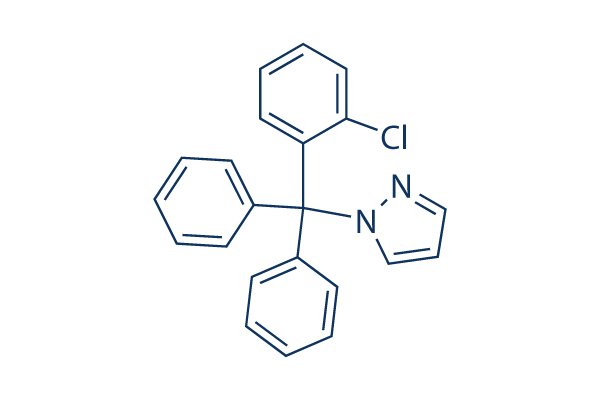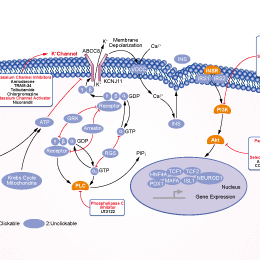
- Bioactive Compounds
- By Signaling Pathways
- PI3K/Akt/mTOR
- Epigenetics
- Methylation
- Immunology & Inflammation
- Protein Tyrosine Kinase
- Angiogenesis
- Apoptosis
- Autophagy
- ER stress & UPR
- JAK/STAT
- MAPK
- Cytoskeletal Signaling
- Cell Cycle
- TGF-beta/Smad
- Compound Libraries
- Popular Compound Libraries
- Customize Library
- Clinical and FDA-approved Related
- Bioactive Compound Libraries
- Inhibitor Related
- Natural Product Related
- Metabolism Related
- Cell Death Related
- By Signaling Pathway
- By Disease
- Anti-infection and Antiviral Related
- Neuronal and Immunology Related
- Fragment and Covalent Related
- FDA-approved Drug Library
- FDA-approved & Passed Phase I Drug Library
- Preclinical/Clinical Compound Library
- Bioactive Compound Library-I
- Bioactive Compound Library-Ⅱ
- Kinase Inhibitor Library
- Express-Pick Library
- Natural Product Library
- Human Endogenous Metabolite Compound Library
- Alkaloid Compound LibraryNew
- Angiogenesis Related compound Library
- Anti-Aging Compound Library
- Anti-alzheimer Disease Compound Library
- Antibiotics compound Library
- Anti-cancer Compound Library
- Anti-cancer Compound Library-Ⅱ
- Anti-cancer Metabolism Compound Library
- Anti-Cardiovascular Disease Compound Library
- Anti-diabetic Compound Library
- Anti-infection Compound Library
- Antioxidant Compound Library
- Anti-parasitic Compound Library
- Antiviral Compound Library
- Apoptosis Compound Library
- Autophagy Compound Library
- Calcium Channel Blocker LibraryNew
- Cambridge Cancer Compound Library
- Carbohydrate Metabolism Compound LibraryNew
- Cell Cycle compound library
- CNS-Penetrant Compound Library
- Covalent Inhibitor Library
- Cytokine Inhibitor LibraryNew
- Cytoskeletal Signaling Pathway Compound Library
- DNA Damage/DNA Repair compound Library
- Drug-like Compound Library
- Endoplasmic Reticulum Stress Compound Library
- Epigenetics Compound Library
- Exosome Secretion Related Compound LibraryNew
- FDA-approved Anticancer Drug LibraryNew
- Ferroptosis Compound Library
- Flavonoid Compound Library
- Fragment Library
- Glutamine Metabolism Compound Library
- Glycolysis Compound Library
- GPCR Compound Library
- Gut Microbial Metabolite Library
- HIF-1 Signaling Pathway Compound Library
- Highly Selective Inhibitor Library
- Histone modification compound library
- HTS Library for Drug Discovery
- Human Hormone Related Compound LibraryNew
- Human Transcription Factor Compound LibraryNew
- Immunology/Inflammation Compound Library
- Inhibitor Library
- Ion Channel Ligand Library
- JAK/STAT compound library
- Lipid Metabolism Compound LibraryNew
- Macrocyclic Compound Library
- MAPK Inhibitor Library
- Medicine Food Homology Compound Library
- Metabolism Compound Library
- Methylation Compound Library
- Mouse Metabolite Compound LibraryNew
- Natural Organic Compound Library
- Neuronal Signaling Compound Library
- NF-κB Signaling Compound Library
- Nucleoside Analogue Library
- Obesity Compound Library
- Oxidative Stress Compound LibraryNew
- Plant Extract Library
- Phenotypic Screening Library
- PI3K/Akt Inhibitor Library
- Protease Inhibitor Library
- Protein-protein Interaction Inhibitor Library
- Pyroptosis Compound Library
- Small Molecule Immuno-Oncology Compound Library
- Mitochondria-Targeted Compound LibraryNew
- Stem Cell Differentiation Compound LibraryNew
- Stem Cell Signaling Compound Library
- Natural Phenol Compound LibraryNew
- Natural Terpenoid Compound LibraryNew
- TGF-beta/Smad compound library
- Traditional Chinese Medicine Library
- Tyrosine Kinase Inhibitor Library
- Ubiquitination Compound Library
-
Cherry Picking
You can personalize your library with chemicals from within Selleck's inventory. Build the right library for your research endeavors by choosing from compounds in all of our available libraries.
Please contact us at [email protected] to customize your library.
You could select:
- Antibodies
- Bioreagents
- qPCR
- 2x SYBR Green qPCR Master Mix
- 2x SYBR Green qPCR Master Mix(Low ROX)
- 2x SYBR Green qPCR Master Mix(High ROX)
- Protein Assay
- Protein A/G Magnetic Beads for IP
- Anti-Flag magnetic beads
- Anti-Flag Affinity Gel
- Anti-Myc magnetic beads
- Anti-HA magnetic beads
- Poly FLAG Peptide lyophilized powder
- Protease Inhibitor Cocktail
- Protease Inhibitor Cocktail (EDTA-Free, 100X in DMSO)
- Phosphatase Inhibitor Cocktail (2 Tubes, 100X)
- Cell Biology
- Cell Counting Kit-8 (CCK-8)
- Animal Experiment
- Mouse Direct PCR Kit (For Genotyping)
- New Products
- Contact Us
TRAM-34
Synonyms: Triarylmethane-34
TRAM-34 (Triarylmethane-34) is a selective and potent inhibitor of the intermediate-conductance Ca2+-activated K+ channel (IKCa1, KCa3.1) with Kd of 20 nM, 200- to 1500-fold selective over other ion channels, and does not block cytochrome P450.

TRAM-34 Chemical Structure
CAS: 289905-88-0
Selleck's TRAM-34 has been cited by 4 publications
Purity & Quality Control
TRAM-34 Related Products
| Related Targets | Ca2+-dependent K+ channel | Click to Expand |
|---|---|---|
| Related Products | Amiodarone HCl Tolbutamide (HLS 831) Glyburide (Glibenclamide) Dofetilide Nicorandil Retigabine 2HCl Sophocarpine ML133 HCl Hydralazine HCl Dronedarone HCl Gliquidone Quinine Nateglinide Hexachlorophene Glipizide Gliclazide Quinidine hydrochloride monohydrate Doxapram Quinine HCl Dihydrate Minoxidil PAP-1 | Click to Expand |
| Related Compound Libraries | FDA-approved Drug Library Natural Product Library Ion Channel Ligand Library Exosome Secretion Related Compound Library Calcium Channel Blocker Library | Click to Expand |
Signaling Pathway
Choose Selective Potassium Channel Inhibitors
Biological Activity
| Description | TRAM-34 (Triarylmethane-34) is a selective and potent inhibitor of the intermediate-conductance Ca2+-activated K+ channel (IKCa1, KCa3.1) with Kd of 20 nM, 200- to 1500-fold selective over other ion channels, and does not block cytochrome P450. | ||
|---|---|---|---|
| Features | Has a therapeutic profile similar to clotrimazole, but TRAM-34 has a superior safety profile. | ||
| Targets |
|
| In vitro | ||||
| In vitro | Unlike clotrimazole, TRAM-34 selectively inhibits IKCa1 without blocking cytochrome P450 enzyme (CYP3A4). TRAM-34 potently inhibits cloned IKCa1 channel in IKCa1-transfected COS-7 cells as well as native IKCa currents in human T lymphocytes and T84 cells with Kd of 20 nM, 25 nM, and 22 nM, respectively, more potently than clotrimazole with Kd of 70 nM, 100 nM, and 90 nM, respectively. TRAM-34 exhibits 200- to 1,500-fold selectivity over other ion channels such as KV, BKCa, SKCa, Na+, CRAC and Cl- channels. TRAM-34 significantly inhibits anti-CD3 Ab or PKC-activator PMA plus calcium-ionophore ionomycin induced activation of human T lymphocytes with IC50 of 295-910 nM and 85-830 nM, respectively. TRAM-34 (5 μM) does not inhibit cell viability of human T lymphocytes or several cell lines. [1] TRAM-34 significantly inhibits EGF-induced IKCa1 up-regulation, and EGF-stimulated proliferation of A7r5 cells with IC50 of 8 nM. [2] TRAM-34 treatment inhibits proliferation of human endometrial cancer (EC) cells, and blocks EC cell cycle at G0/G1 phase. [3] Inhibition of the IKCa1 channel by TRAM-34 (1-30 μM) leads to dose-dependent suppression of the proliferation but not apoptosis of LNCaP and PC-3 prostate cancer (PCa) cells, involving an increase of p21Cip1 and cell arrest in the G1 cycle. [4] | |||
|---|---|---|---|---|
| Kinase Assay | Electrophysiology | |||
| The human IKCa1 is cloned and expressed in COS-7 cells. Cells are studied in the whole-cell configuration of the patch-clamp technique. The holding potential is 280 mV. The internal pipette solution contains: 145 mM K+ aspartate, 2 mM MgCl2, 10 mM Hepes, 10 mM K2EGTA, and 8.5 mM CaCl2 (1 μM free Ca2+), pH 7.2, 290-310 mOsm. To reduce currents from the native chloride channels in COS-7 cells, Na+ aspartate Ringer is used as an external solution: 160 mM Na+ aspartatey/4.5 mM KCl/2 mM CaCl2/1 mM MgCl2/5 mM Hepes, pH 7.4/290-310 mOsm. IKCa currents in COS-7 cells are elicited by 200-ms voltage ramps from -120 mV to 40 mV applied every 10 seconds and the reduction of slope conductance at -80 mV by TRAM-34 taken as a measure of channel block. | ||||
| Cell Research | Cell lines | Human T lymphocytes, Jurkat E6-1, MEL, C2F3, CHO, COS-7, L929, NGP, NLF, and RBL-2H3 | ||
| Concentrations | Dissolved in DMSO, final concentration ~10 μM | |||
| Incubation Time | 48 hours | |||
| Method | Cells are exposed to TRAM-34 for 48 hours. After 48 hours, cells are harvested by suction (suspension cells) or by trypsinization (adherent cell lines), centrifuged, resuspended in 0.5 mL PBS containing 1 μg/mL propidium iodide (PI), and red fluorescence measured on a FACScan flow cytometer. The percentage of dead cells is determined by their PI uptake, 104 cells of every sample being analyzed. | |||
| In Vivo | ||
| In vivo | TRAM-34 treatment at ~500-1,000 times the channel-blocking dose (0.5 mg/kg/day) for 7 days is nontoxic to mice. [1] Administration of TRAM-34 at 120 mg/kg/day significantly reduces intimal hyperplasia by ~40% in a rat model of balloon catheter injury (BCI). [2] Consistent with its in vitro role in inhibiting the proliferation of EC cells, TRAM-34 treatment at 30 μM slows the development of HEC-1-A tumor in vivo. [3] | |
|---|---|---|
| Animal Research | Animal Models | Sprague-Dawley rats subjected to BCI of the left CA by use of a 2F Fogarty embolectomy catheter |
| Dosages | 120 mg/kg/day | |
| Administration | Subcutaneous injection | |
Chemical Information & Solubility
| Molecular Weight | 344.84 | Formula | C22H17ClN2 |
| CAS No. | 289905-88-0 | SDF | Download TRAM-34 SDF |
| Smiles | C1=CC=C(C=C1)C(C2=CC=CC=C2)(C3=CC=CC=C3Cl)N4C=CC=N4 | ||
| Storage (From the date of receipt) | |||
|
In vitro |
cyclohexane : 8 mg/mL DMSO : 0.4 mg/mL ( (1.15 mM); Moisture-absorbing DMSO reduces solubility. Please use fresh DMSO.) Water : Insoluble |
Molecular Weight Calculator |
|
In vivo Add solvents to the product individually and in order. |
In vivo Formulation Calculator |
||||
Preparing Stock Solutions
Molarity Calculator
In vivo Formulation Calculator (Clear solution)
Step 1: Enter information below (Recommended: An additional animal making an allowance for loss during the experiment)
mg/kg
g
μL
Step 2: Enter the in vivo formulation (This is only the calculator, not formulation. Please contact us first if there is no in vivo formulation at the solubility Section.)
% DMSO
%
% Tween 80
% ddH2O
%DMSO
%
Calculation results:
Working concentration: mg/ml;
Method for preparing DMSO master liquid: mg drug pre-dissolved in μL DMSO ( Master liquid concentration mg/mL, Please contact us first if the concentration exceeds the DMSO solubility of the batch of drug. )
Method for preparing in vivo formulation: Take μL DMSO master liquid, next addμL PEG300, mix and clarify, next addμL Tween 80, mix and clarify, next add μL ddH2O, mix and clarify.
Method for preparing in vivo formulation: Take μL DMSO master liquid, next add μL Corn oil, mix and clarify.
Note: 1. Please make sure the liquid is clear before adding the next solvent.
2. Be sure to add the solvent(s) in order. You must ensure that the solution obtained, in the previous addition, is a clear solution before proceeding to add the next solvent. Physical methods such
as vortex, ultrasound or hot water bath can be used to aid dissolving.
Tech Support
Answers to questions you may have can be found in the inhibitor handling instructions. Topics include how to prepare stock solutions, how to store inhibitors, and issues that need special attention for cell-based assays and animal experiments.
Tel: +1-832-582-8158 Ext:3
If you have any other enquiries, please leave a message.
* Indicates a Required Field
Tags: buy TRAM-34 | TRAM-34 supplier | purchase TRAM-34 | TRAM-34 cost | TRAM-34 manufacturer | order TRAM-34 | TRAM-34 distributor








































